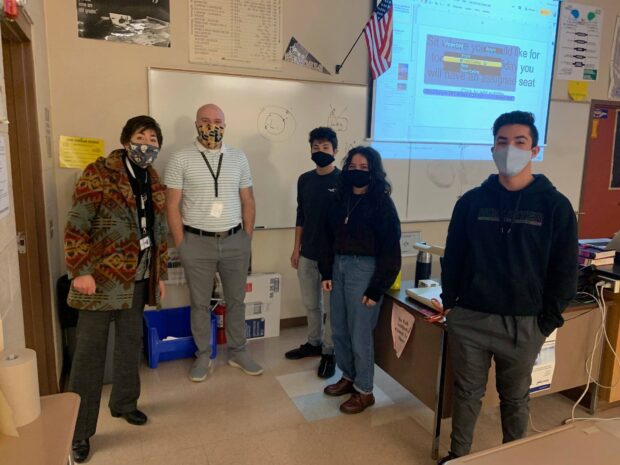The new year has ushered in a new shot at in-person learning for students across Idaho.
A pre-holiday surge in COVID-19-related absences prompted many districts across the state to take learning fully online before winter break.
Several of those districts are now reopening their doors to students.
Despite a trend toward in-person learning, back-to-school plans remain mixed from district to district.
Here’s a rundown of what’s happening across the state:
For the most up-to-date plans in your school district or charter, check out Idaho Education News’ map of school operating plans.
East Idaho
Though some East Idaho districts have maintained hybrid learning models since Christmas, students across the region are back in their classrooms full-time — including those who moved to fully remote-learning models amid a pre-holiday surge of confirmed cases of COVID-19.
- The Snake River district shifted its middle school to a fully remote model a week before Christmas break in response to increased cases of COVID-19 among staff. The students returned full time to their classrooms Monday.
- Students in the Teton School District are also back full time after a stint with fully at-home learning, which followed a surge of local cases in November.
Despite an overall emphasis on in-person teaching and learning, the region’s biggest districts have maintained some focus on remote instruction.
- Middle school and high school students in the Pocatello-Chubbuck district returned to a partial at-home learning model Monday. The district’s K-5 students continue to learn fully in-person, with some minor variations. Trustees voted Tuesday to keep these plans in place through February.
- The Idaho Falls district likewise adopted a hybrid-learning model for its three high schools months ago. However, these students returned from the holidays to a four-day-a-week schedule, the district announced on its webpage. All Idaho Falls students now attend on a four-day schedule and learn remotely once a week.
- Secondary students in East Idaho’s largest district, Bonneville, still learn from home on Mondays, with the rest for the week designated for in-person learning. All of the district’s elementary students are learning full time in school. Click here for weekly updates on Bonneville’s instructional model.
Ten of East Idaho 13 counties are still in the “orange” risk level for community spread of COVID-19, with 2.5-to-5 confirmed cases per 10,000 people.
North Idaho
The landscape in North Idaho is more mixed. School districts in three of the state’s four northernmost counties are operating in the “red” risk level for the spread of COVID-19, with over 5 cases per day for every 10,000 people.
Still, several districts in these counties are operating fully in-person, including Bonner County’s Lake Pend Orielle and the West Bonner County district.
The region’s largest district, Kootenai County-based Coeur d’Alene, is operating at an “orange” risk level for community spread. The district has stayed the course with a hybrid learning model that allows Coeur d’Alene’s K-5 students to learn remotely on Wednesdays and secondary students to learn online three days a week.
The Latah County-based Moscow district has also maintained a hybrid-learning model through the holidays, despite a “yellow” risk designation, with 1-to-2.5 cases per day for every 10,000 people.
Other area schools have changed course since the holidays. Coeur d’Alene Academy had been on a fully remote learning model, yet students are now allowed to attend in person four days a week, principal Dan Nicklay told EdNews Tuesday.
Southwest Idaho
Most school districts in the southwestern part of the state are operating in the “red” risk level for the spread of COVID-19.
Local response to that risk is anything but uniform.
In the state’s largest district, Meridian’s West Ada, students in K-5 returned in-person Monday. Sixth through 12th graders are in-person every other day on an alternating hybrid schedule. West Ada’s 38,000 students had also been on a hybrid-learning model before the holidays, an outlier as other large districts in the area moved exclusively online.
Boise, Nampa and Caldwell moved to remote learning last year following surging COVID cases and high numbers of staff and student absences. Those three districts started the 2021 calendar year in remote learning but could bring students back to school buildings by the end of the month.
Nampa’s School Board, which adopted online learning in late November, voted Tuesday to allow pre-K and elementary students back in-person, and to adopt hybrid learning for secondary students by January 19.
Caldwell also plans to return to a hybrid learning schedule by January 19. Boise trustees meet on Monday, Jan. 11, to discuss next steps in that district.

Smaller districts and charters scattered throughout the region are generally doing their own things. Rolling Hills Charter school, which serves about 250 students in Boise, has students in buildings full time. All but one district in Payette county is hosting full-time, in-person school, while Vallivue is opening in a hybrid situation on Jan. 7.
Central Idaho
The risk of COVID-19 spread becomes more of a mixed bag toward the central part of the state. Twin Falls and Cassia counties are considered at medium risk for COVID-19 spread. Jerome and Blaine counties are in the high-risk category. But central Gooding and Camas county risk levels are considered low.
More than 10,000 students in the large Twin Falls school district went back to school on Monday. Under a “modified yellow” protocol, students are back in buildings four days a week and Mondays are set aside for distance learning.
Blaine County schools are operating on a hybrid schedule, and Wednesdays are learn-from-home days in the Jerome School District. In low-risk Gooding and Camas counties school is operating in person.
Reporters Sami Edge and Devin Bodkin contributed to this report.
